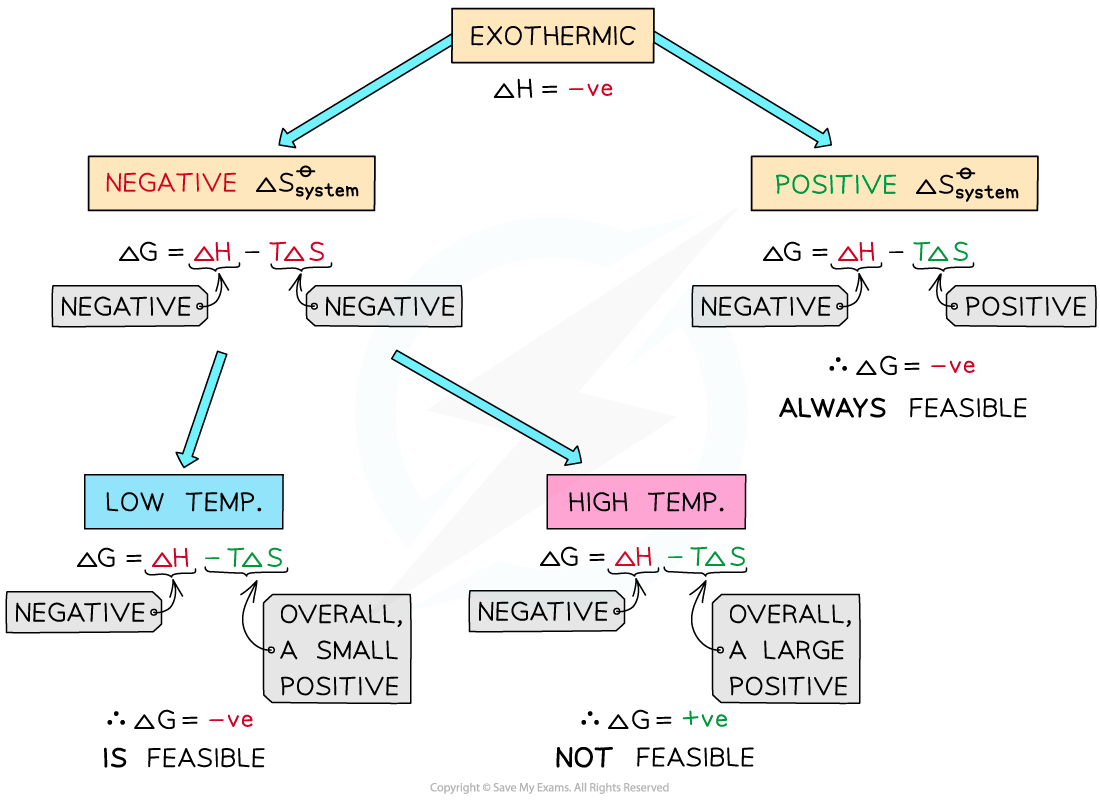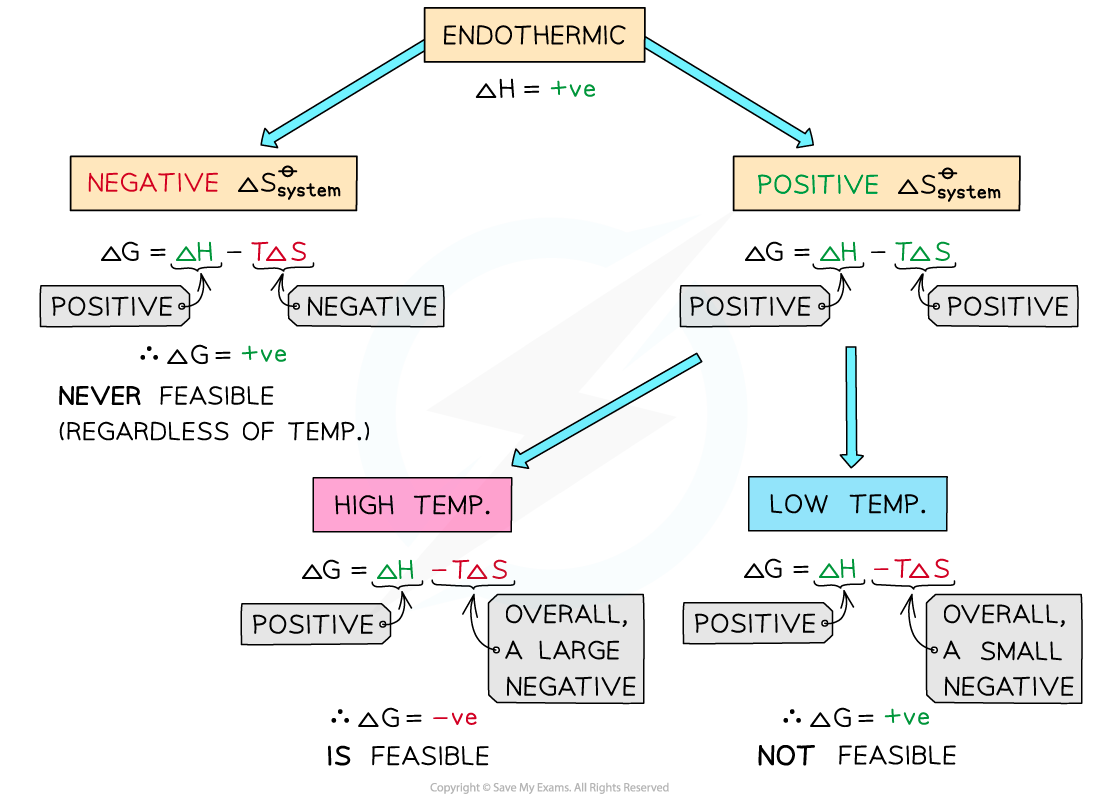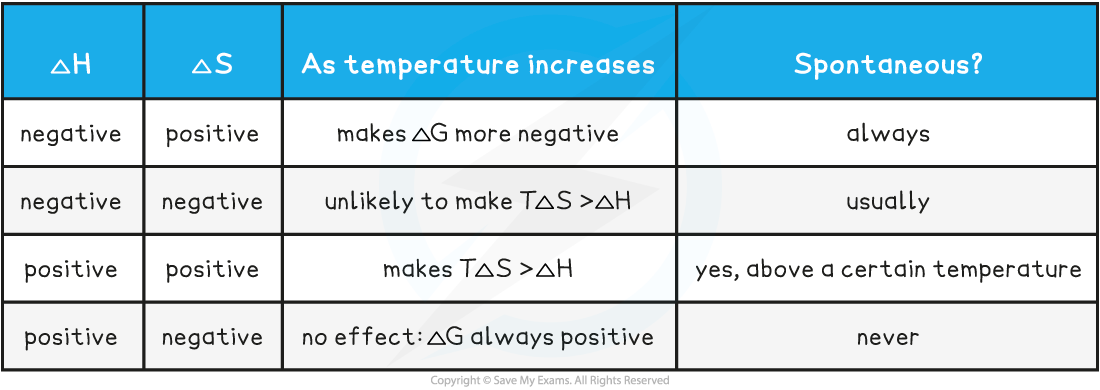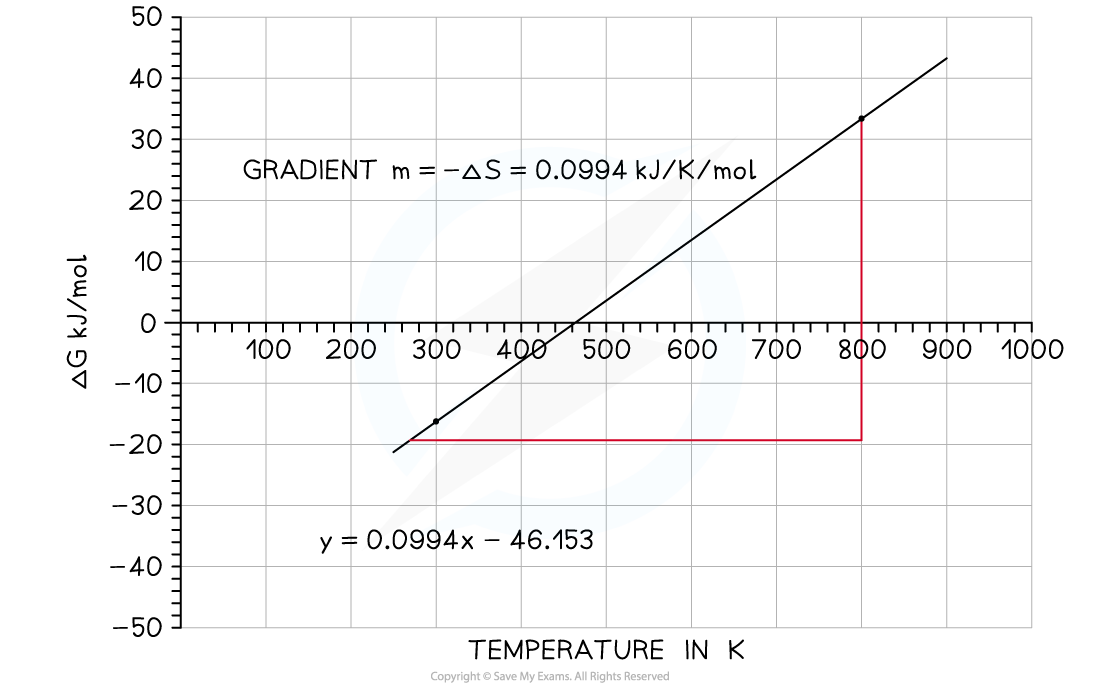Reaction Feasibility (AQA A Level Chemistry): Revision Note
Exam code: 7405
Reaction Feasibility
The Gibbs equation can be used to calculate whether a reaction is feasible or not
ΔGꝋ = ΔHreactionꝋ - TΔSsystemꝋ
When ΔGꝋ is negative, the reaction is feasible and likely to occur
When ΔGꝋis positive, the reaction is not feasible and unlikely to occur
Feasible and spontaneous are fairly similar terms to describe reactions
Feasible tends to be used to describe reactions which are energetically favourable, so reactions that should go
Spontaneous tends to be used to describe reactions that go of their own accord
Summary for temperature and Gibbs free energy

Worked Example
Determining the feasibility of a reactionCalculate the Gibbs free energy change for the following reaction at 298 K and determine whether the reaction is feasible.
2Ca (s) + O2 (g) → 2CaO (s) ΔH = -635.5 kJ mol-1
Sꝋ[Ca(s)] = 41.00 J K-1 mol-1
Sꝋ[O2(g)] = 205.0 J K-1 mol-1
Sꝋ[CaO(s)] = 40.00 J K-1 mol-1
Answer
Step 1: Calculate ΔSsystemꝋ
ΔSsystemꝋ = ΣΔSproductsꝋ - ΣΔSreactantsꝋ
ΔSsystemꝋ = (2 x ΔSꝋ [CaO(s)]) - (2 x ΔSꝋ [Ca(s)] + ΔSꝋ [O2(g)])
= (2 x 40.00) - (2 x 41.00 + 205.0)
= -207.0 J K-1 mol-1
Step 2: Convert ΔSꝋ to kJ K-1 mol-1
= -207.0 J K-1 mol-1÷ 1000 = -0.207 kJ mol-1
Step 3: Calculate ΔGꝋ
ΔGꝋ = ΔHreactionꝋ - TΔSsystemꝋ
= -635.5 - (298 x -0.207)
= -573.8 kJ mol-1
Step 4: Determine whether the reaction is feasible
Since the ΔGꝋ is negative the reaction is feasible
Reaction Feasibility: Temperature Changes
The feasibility of a reaction can be affected by the temperature
The Gibbs equation will be used to explain what will affect the feasibility of a reaction for exothermic and endothermic reactions

Exothermic reactions
In exothermic reactions, ΔHreactionꝋ is negative
If the ΔSsystemꝋ is positive:
Both the first and second term will be negative
Resulting in a negative ΔGꝋ so the reaction is feasible
Therefore, regardless of the temperature, an exothermic reaction with a positive ΔSsystemꝋ will always be feasible
If the ΔSsystemꝋ is negative:
The first term is negative and the second term is positive
At very high temperatures, the -TΔSsystemꝋ will be very large and positive and will overcome ΔHreactionꝋ
Therefore, at high temperatures ΔGꝋ is positive and the reaction is not feasible
Since the relative size of an entropy change is much smaller than an enthalpy change, it is unlikely that TΔS > ΔH as temperature increases
These reactions are therefore usually spontaneous at normal conditions

The diagram shows under which conditions exothermic reactions are feasible
Endothermic reactions
In endothermic reactions, ΔHreactionꝋ is positive
If the ΔSsystemꝋ is negative:
Both the first and second term will be positive
Resulting in a positive ΔGꝋ so the reaction is not feasible
Therefore, regardless of the temperature, endothermic with a negative ΔSsystemꝋ will never be feasible
If the ΔSsystemꝋ is positive:
The first term is positive and the second term is negative
At low temperatures, the -TΔSsystemꝋ will be small and negative and will not overcome the larger ΔHreactionꝋ
Therefore, at low temperatures ΔGꝋ is positive and the reaction is not feasible
The reaction is more feasible at high temperatures as the second term will become negative enough to overcome the ΔHreactionꝋ resulting in a negative ΔGꝋ
This tells us that for certain reactions which are not feasible at room temperature, they can become feasible at higher temperatures
An example of this is found in metal extractions, such as the extraction if iron in the blast furnace, which will be unsuccessful at low temperatures but can occur at higher temperatures (~1500 oC in the case of iron)

The diagram shows under which conditions endothermic reactions are feasible
A summary table of free energy conditions

Free Energy Vs Temperature Graphs
Rearranging the Gibbs equation allows you to determine the temperature at which a non-spontaneous reaction become feasible
ΔGꝋ = ΔHreactionꝋ - TΔSsystemꝋ
For a reaction to be feasible ΔGꝋ must be zero or negative
0 = ΔHꝋ - TΔSꝋ
ΔHꝋ = TΔSꝋ
T = ΔHꝋ / ΔSꝋ
Worked Example
At what temperature will the reduction of aluminium oxide with carbon become spontaneous?
Al2O3(s) + 3C(s) → 2Al(s) + 3CO(g) ΔHꝋ = +1336 kJ mol-1 ΔSꝋ = +581 J K-1mol-1
Answer:
If ΔG = 0 then , T = ΔHꝋ / ΔSꝋ
T = 1336 ÷ (581/1000)
T = 2299 K
Graphing the Gibbs Equation
The Gibbs equation can be expressed as the equation for a straight line
ΔGꝋ = ΔHꝋ - TΔSꝋ
ΔGꝋ = - ΔSꝋT + ΔHꝋ
y = mx + c
A graph of free energy versus temperature (in K) will give a straight line, with slope -ΔSꝋ and y-intercept, ΔHꝋ.
The variation of ΔGꝋ against T for the synthesis of ammonia has been plotted below:
N2 (g) + 3H2 (g)⇌ 2NH3 (g)

Graph of free energy versus temperature for the synthesis of ammonia
From this graph you should be able to see some key features:
The x-intercept shows you where the reaction ceases to be spontaneous, in this case at 460 K (187 oC)
Above this temperature ΔGꝋ is positive so the reaction is not feasible
However, you may recall that the operating conditions of the Haber process are higher than this temperature, but this graph takes no account of the use of a catalyst which affects the energetics of the system, nor does it take into account anything about the rate of reaction or the fact that it is an equilibrium and removal of the ammonia as soon as it is formed also tips the balance in favour of the product
The y-intercept shows you reaction is exothermic which you can see from the enthalpy of formation; the value is approximately -46 kJ mol -1
An exothermic equilibrium reaction would be favoured by lower temperatures - this is seen by the value of ΔGꝋ becoming increasingly negative as the temperature falls
Examiner Tips and Tricks
You will notice that the line on the graph does not continue below 240 K. The simple reason for this is that at this point the ammonia will have reached it boiling point and so the gradient would change because it is now liquid ammonia.

Unlock more, it's free!
Did this page help you?